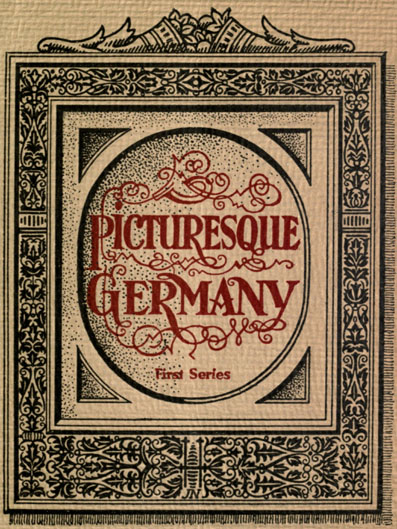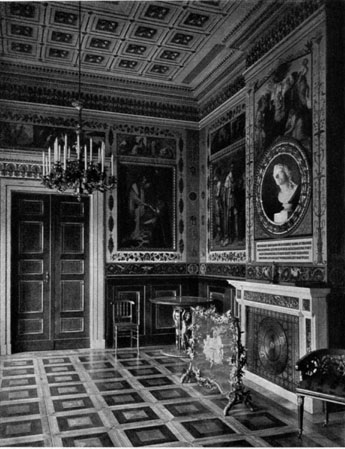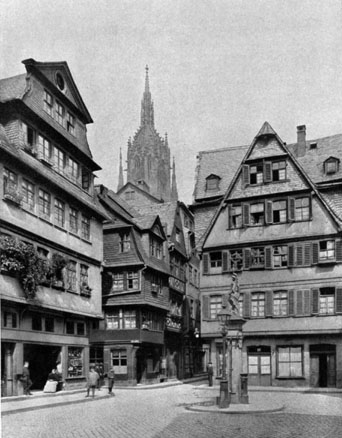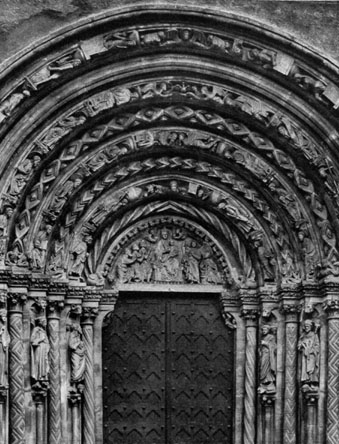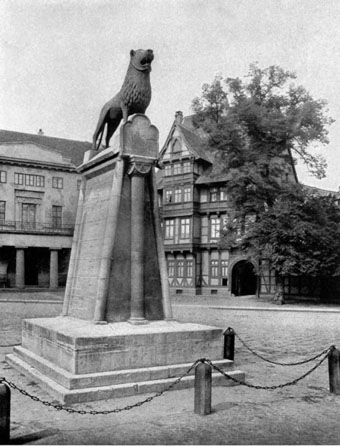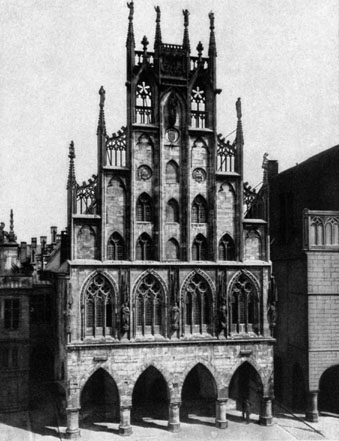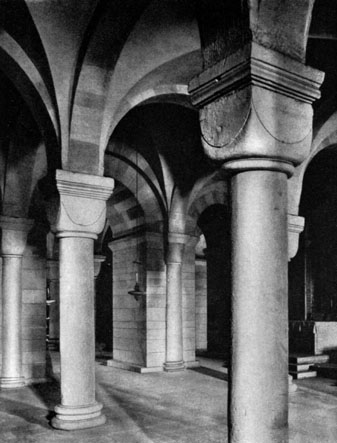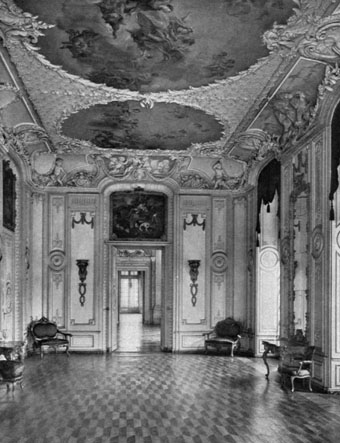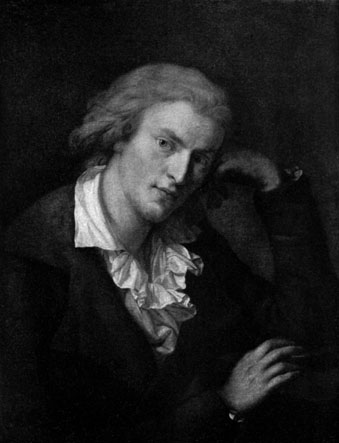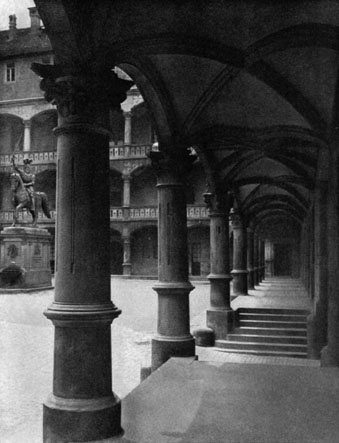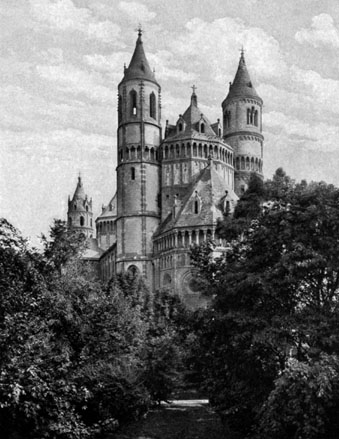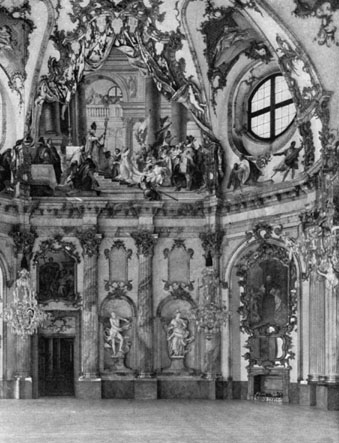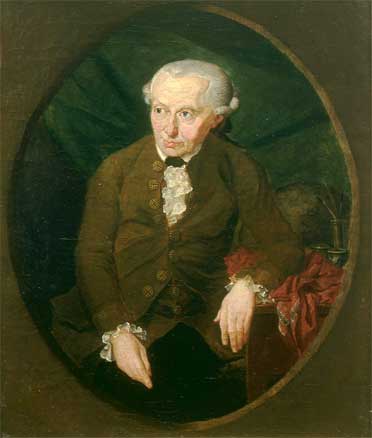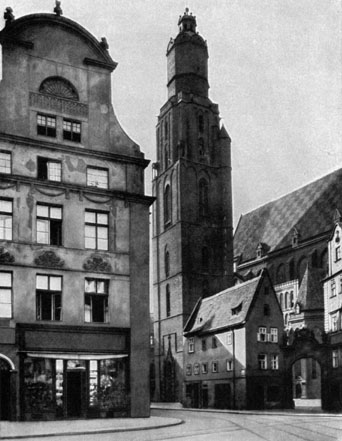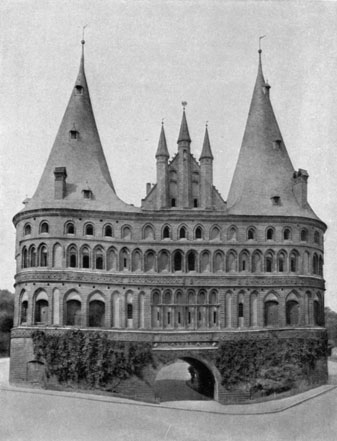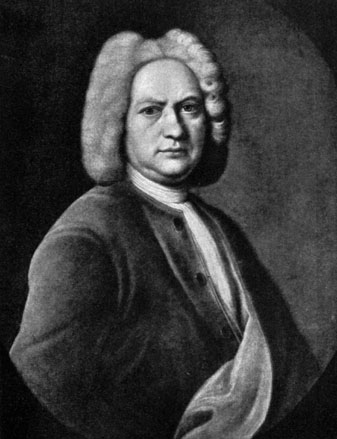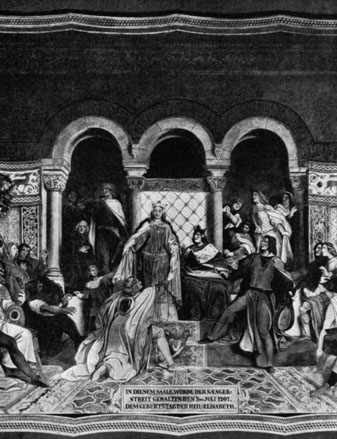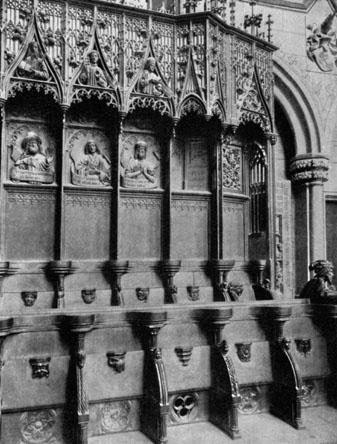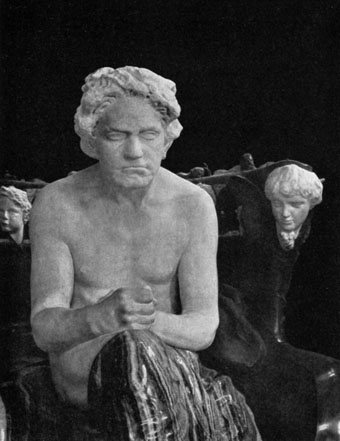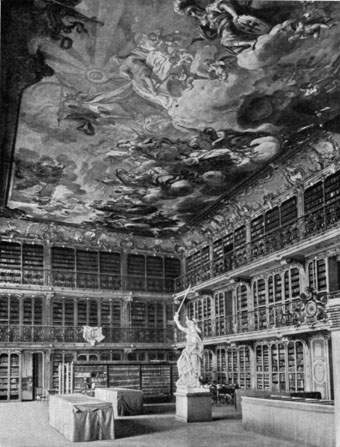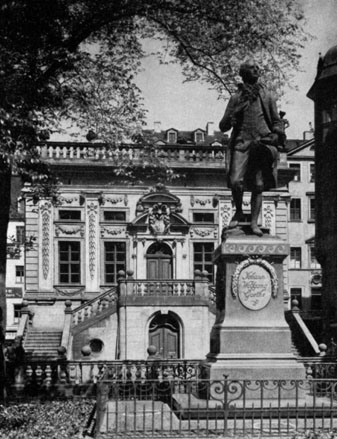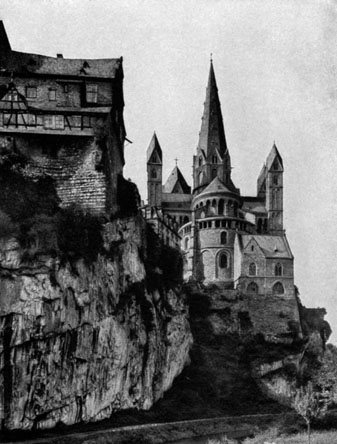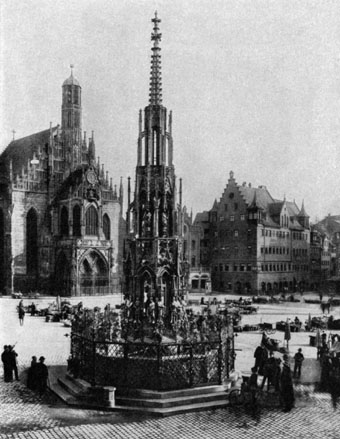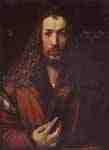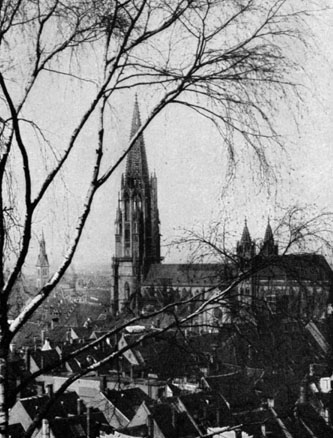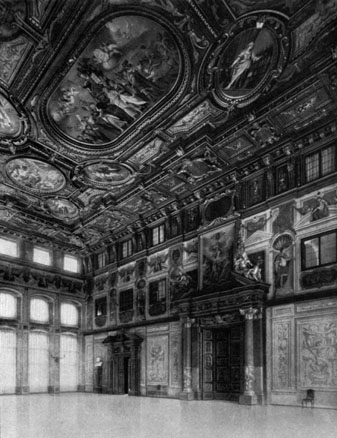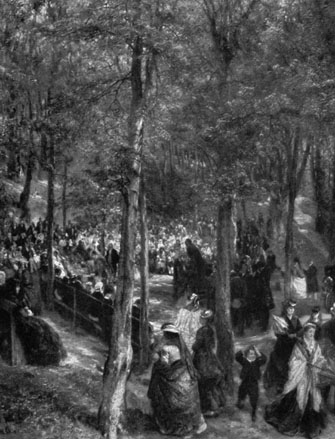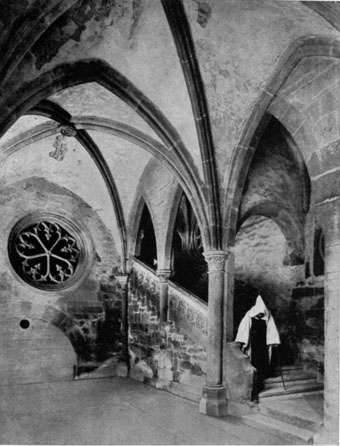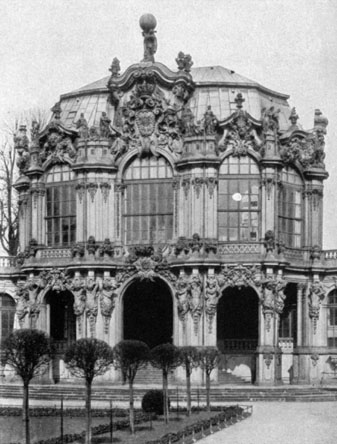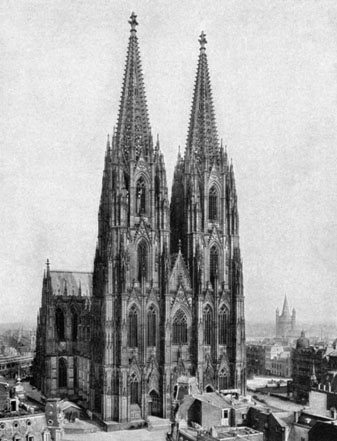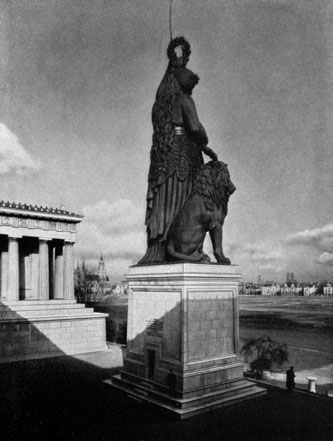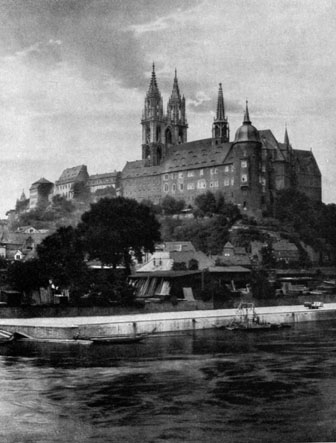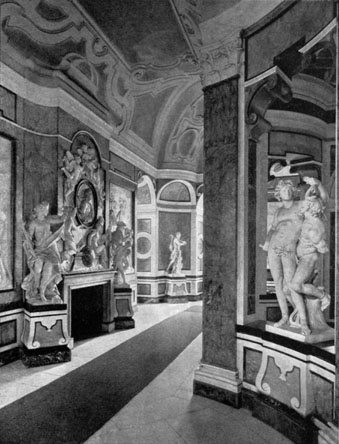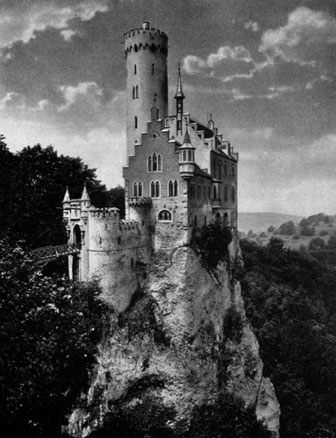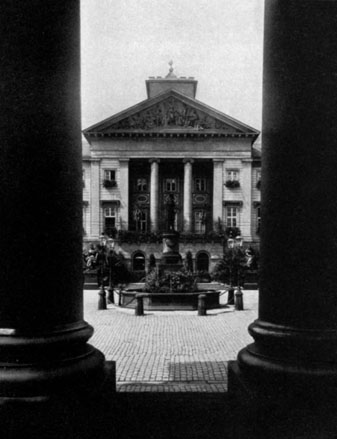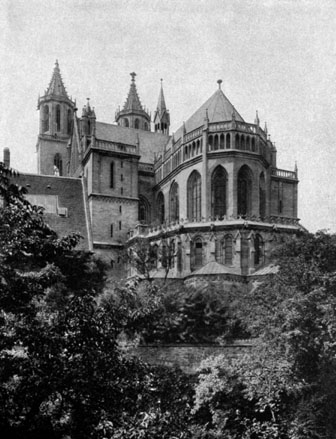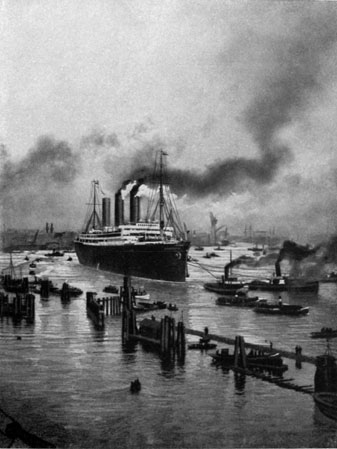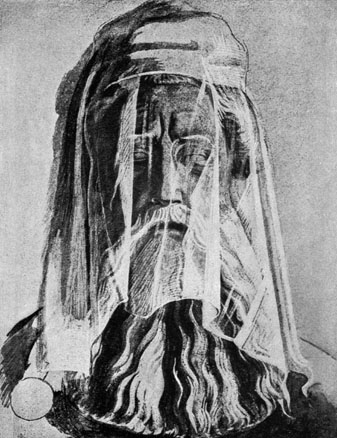.
Johann Wolfgang von Goethe / born at Francfort on the Main, August 28, 1749 / died at Weimar, March 22, 1832 / Painting by Karl Joseph Stieler in the New Pinacothek, Munich / Photograph by Piloty and Löhle, Munich
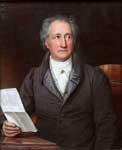
The Poet’s Room in the castle at Weimar / Bust of Frederick von Schiller on the right / Photograph by Louis Held, Weimar
Picturesque spot in Frankfort on the Main / Saalgasse (Saal Street) with the Holy Ghost Fountain. In the background can be seen the tower of the Cathedral, the foundation of which was laid in 874 / Photograph by the National Messbildanstalt, Berlin
A monument from the time of the Roman Emperors in Germany / The “Porta nigra” at Treves (Trier) on the Moselle, a Roman gateway dating from the 4th century / Photograph by the National Messbildanstalt, Berlin
The golden portal of the Cathedral at Freiberg in Saxony / Ruins of the former Church of our Lady. About 1230 / The absolute climax in the development of the Romanesque Portal, which produced so much of rare beauty (Dehio) / The style of this creation is of the most perfect delicacy and charm (Lübke) / Partial view from a photograph by the National Messbildanstalt, Berlin
The Pillar of Justice with the Bronze Lion on the Burgplatz in Brunswick (Braunschweig) / Erected by Henry the Lion in 1166 / Photograph by the National Messbildanstalt, Berlin
A jewel of German Gothic architecture in freestone / The Town-hall at Münster, Westphalia, built about 1350 / Photograph by Dr. Erwin Quedenfeldt, Düsseldorf
The Cathedral at Spires (Speyer) / As the burial place of many monarchs, it represents a monument of German history / View of the magnificent crypt of the Cathedral. The edifice founded in 1030 by Conrad II, was destroyed several times but finally rebuilt by King Maximilian I of Bavaria, consecrated in 1822 and completed in 1858 / From a photograph by Professor Neeb, Mainz
Hall in Benrath Castle near Düsseldorf / Built by Nikolaus de Pigage for Elector Karl Theodor of the Palatinate / The interior represents a graceful link between the Rococo and the Classic / From a photograph by the National Messbildanstalt, Berlin
Johann Christoph Friedrich von Schiller, born at Marbach on the Neckar, November 10, 1759, died at Weimar, May 9, 1805 / From the painting by Anton Graff in the Körner Museum, Dresden / Photograph by R. Tamme, Dresden, successor of F. and O. Brockmann
Courtyard of the Old Castle in Stuttgart / The architectural climax of the Residence of the Württemberg Princes, re-constructed since 1553 by Alberlin Tretsch assisted by Blasius and Martin Berwart / Ludwig Hofer’s equestrian statue of Count Eberhard, the Bearded, is in the courtyard / From a photograph by the Techno-Photographischen Archivs Hans Herzberg, Berlin
The Cathedral at Worms, founded in 1100, consecrated in 1181 / One of the finest specimens of Romanesque architecture in Germany / From a photograph by the National Messbildanstalt, Berlin
The Emperor’s Hall in the Residence at Wurzburg, the most beautiful Castle in the Rococo style and one of the finest specimens of 18th century architecture in Germany / The masterpiece of Johann Balthasar Neumann (1687–1753) / The painting in the Hall, “The Marriage of the Emperor Barbarossa” was executed by G. B. Tiepolo / Photograph by K. Gundermann, Wurzburg
Court in the Castle at Heidelberg / View of the portion built by Otto Heinrich, begun in 1556, completed in 1563 / The masterpiece of the German Renaissance / Creation of Hans Engelhardt / With the permission of Edm. von König Co, Inc. Heidelberg
Immanuel Kant, born at Königsberg, East Prussia, April 22, 1724, died at Königsberg, February 12, 1804 / From the painting by Döbler / Reprint from the “Corpus Imaginum” of the Photographischen Gesellschaft, Charlottenburg.
Beautiful embodiment of different styles of period architecture / The Elizabeth Church in Breslau (founded in 1253) and its surroundings / The tower of the Church is 91 meters high / From a photograph by Waldemar Titzenthaler, Berlin
Masterpiece of Gothic architecture in brick in Northern Germany / The Holstentor (Holsten Gate) in Lübeck, built by Hinrich Helmsted, 1470–1477, an imposing monument of the architecture of civic fortifications / From a photograph by the National Messbildanstalt, Berlin
Johann Sebastian Bach, born at Eisenach, March 21, 1685, died at Leipzig, July 28, 1750 / From the painting by Johann Jakob Ihle / Reprint from the Corpus Imaginum of the Photographischen Gesellschaft, Charlottenburg
The contest of the Minnesingers at the Wartburg / Part of the fresco in the Castle of the Wartburg in Eisenach, Thuringia, painted in 1855 by Moritz von Schwind / The Landgravine Elizabeth, before whom is kneeling Heinrich von Ofterdingen, is painted in the likeness of the Grand Duchess Amalie of Weimar (1739–1807) the patroness and protector of German poesy in Weimar
Portion of the Choir stalls in the Cathedral Church at Ulm / One of the most perfect and beautiful of the old Gothic Choir stalls in Germany / Carved in oak. Masterpiece of the elder Jörg Syrlin, 1469–1474 / Photograph by the Münsterbauamt in Ulm
Ludwig van Beethoven, born at Bonn on the Rhine, December 16, 1770, died in Vienna, March 26, 1827 / The Beethoven Statue by Max Klinger in the Municipal Museum at Leipzig / With the permission of E. A. Seemann Co, Leipzig
The library in the former residence of the Electors at Mannheim, built in 1720–1759 by Nikolaus de Pigage / Splendid specimen of a masterpiece of the Baroque period / From a photograph by Josef Kuld, Mannheim
Monument of the young Goethe in the Naschmarkt (Nasch Market) in Leipzig, work of Karl Seffner / In commemoration of the poet’s student days in Leipzig, 1765–1768 / Behind the monument is the old Exchange, a delightful specimen of the Baroque style dating from 1678
Richard Wagner, born at Leipzig, May 22, 1813, died in Venice, February 13, 1883 / From the painting by Franz von Lenbach / Reprint from the Corpus Imaginum of the Photographischen Gesellschaft, Charlottenburg
Town-hall and Market Church at Hannover / The Church was completed in 1359, the Town-hall for the most part, dates from the year 1453–1455 / Photograph by the Techno-Photographischen Archiv Hans Herzberg, Berlin
From the golden period of the German Renaissance / The winding staircase in the Gulden Chamber of the Town-hall at Bremen / A masterpiece of wood-carving dating from 1616 / From a photograph by the National Messbildanstalt, Berlin
View of the Cathedral at Limburg on the Lahn / Beautifully picturesque edifice (1213–1242) / Most brilliant monument of the Rhenisch transition style / From a photograph by the National Messbildanstalt, Berlin
Nuremberg, the city of the Minnesingers / The Church of Our Lady (1355–1361) / In front of the Church is the Beautiful Fountain, an exquisite creation of old Nuremberg plastic, erected in 1385–1396 under the direction of Heinrich dem Palier / From a photograph by M. Stich, Nuremberg
Albrecht Dürer, born at Nuremberg, May 21, 1471, died in Nuremberg, April 6, 1528 / Artist’s portrait of himself, 1500, now in the Old Pinakothek, Munich
View of the Cathedral Church at Freiburg in Breisgau (Baden) / The nave begun in 1250 / The earliest and most perfect Gothic tower with pyramid of perforated masonery, existing in Germany / From a photograph by G. Röbecke, Freiburg in Breisgau
The Gold Room in the Town-hall at Augsburg / Built by Elias Holl in 1615–1620 / A magnificent and effective masterpiece of the late Renaissance period / From a photograph by Fritz Höfle, Augsburg
The Cathedral at Regensburg, begun in 1275, completed in 1869 / The rich facade with the three cornered vestibule executed by Lybhart the Mynner, 1385–1395 / From a photograph by M. Stich, Nuremberg
Adolf von Menzel, born at Breslau, December 8, 1815, died in Berlin, February 9, 1905 / Mission Service in the Beech Hall near Kösen (1868) / With the permission of F. Bruckmann Co, Munich
A bit of classic Berlin / The Museum Island / View of the National Gallery / Built in 1866–1876 by Joh. Heinrich Strack and Georg Gustav Erbkam from the designs of Stüler / From a photograph by W. Titzenthaler, Berlin
The most beautiful specimen of an early Gothic cloister in Germany / The Cistercian Cloister Maulbronn in Württemberg, reconstructed in 1201 / The so-called “Hell stairway” in the Cloister / From a photograph by August Krüger, Maulbronn
The Zwinger (bastion) at Dresden / Court surrounded by six pavilions joined together by galleries. / A wonder-work of German Baroque, built 1711–1722 by Matthäus Daniel Pöppelmann (born at Dresden in 1662, died in Dresden in 1736) / With the permission of the Neuen Photographischen Gesellschaft, Berlin-Steglitz
From the golden period of commerce in the German Moyenage / The Artus or Junker Court in Dantzig, the festival hall of the Dantzig merchants / Master Heinrich Holzapfel of Cologne finished the magnificent stalls of the Hall in 1531 / From a photograph by the National Messbildanstalt, Berlin
The crown of Gothic architecture in Germany / The Cathedral at Cologne on the Rhine / Begun in 1248 under Gerhard von Rile; restoration in 1842 under Zwirner, completed in 1880 by Voigtel / From a photograph by the National Messbildanstalt, Berlin
Wilhelm Leibl, born at Cologne on the Rhine, October 23, 1844, died in Würzburg, December 4, 1900 / “Dachauer Peasant Women” (1875), hanging in the National Gallery, Berlin / With the permission of the Photographischen Gesellschaft, Charlottenburg
The Bavaria in front of the Hall of Fame in Munich / Erected by King Ludwig I, 1843–1853 / The Hall of Fame built by Leo von Klenze, the colossal statue of the Bavaria modeled by Schwanthaler, cast by Ferdinand Miller / From a photograph by Jaeger and Görgen, Munich
Late Gothic architecture in Saxony / The Albrecht Castle in Meissen / Built by Master Arnold in 1471 / The Cathedral erected on the summit in 1260–1450 / From a photograph by Waldemar Titzenthaler, Berlin
The celebrated marble-bath pavilion of Pierre Francois Monnot in the Aue (Meadow) at Cassel / The Castle consists of the Orangery, built by the Hugenot, Paul Dury, 1701–1711, the castle built in 1765 and the bath, completed in 1728 / From a photograph by the National Messbildanstalt, Berlin
Lichtenstein Castle near Reutlingen in Württemberg / Built in 1841 by Heideloff on the site of the old citadel, Lichtenstein, made famous by Wilhelm Hauff’s romance / From a photograph by Ludwig Schaller, Stuttgart
Karlsruhe in Baden, the birthplace of Viktor von Scheffel / Glimpse of the center of the town-hall on the market-place through the pillars of the Protestant Church / Built by Fr. Weinbrenner in the beginning of the 19th century / From a photograph by the Badischen Denkmäler-Archivs Kratt, Karlsruhe
The Choir in the Cathedral at Magdeburg / The Choir, begun in 1208, is the earliest specimen of Gothic architecture in Germany. Nave consecrated in 1363 / From a photograph by the National Messbildanstalt, Berlin
Picturesque view on the German shores of the North Sea / In the harbor at Hamburg / From a photograph by Schaul, Hamburg
The Karl frescoes in the Town-hall at Aix-la-Chapelle (Aachen) / Painted by Alfred Rethel in 1840–1862 / Head of the dead Emperor from the fresco “Visit of Otto III to the Grave of Karl the Great” / Sketch in the cabinet of Engravings at Dresden
Title
and decorations
by Julius Nitsche, Munich /
Etchings by F. Bruckmann, Graphische Anstalt,
Munich / Paper from the Scheufelen Paper Factory,
Oberlenningen-Teck, Württemberg / Two-tone
prints by E. T. Gleitsmann, Dresden /
Printed by Carl Gerber,
Munich
First Series
The following are in course of preparation: Second Series: German Industries / Third Series: German Landscapes / Fourth Series: German Spas / Fifth Series: German Museums etc. / All these volumes may be obtained at the place as Series 1

